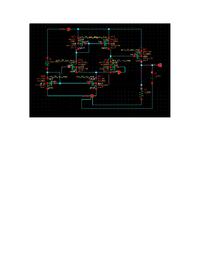bharathr87
Member level 1

overdrive voltage 0.1
I need high values of overdrive voltage, 0.1V<Vgs-Vth<0.15V, for the transistors so as to reduce the effect of mismatch..but for this ckt i am gettin very low values of Vgs-Vth for the nmos and the pmos transistors...increasing the bias current decreases the openloop gain of the first stage(which i want to be >100) and also does not increase Vgs by much...also changing W/L once again decreases the gain... so what should i do to increase the overdrive voltage without decreasing the open loop gain of the first stage?

I need high values of overdrive voltage, 0.1V<Vgs-Vth<0.15V, for the transistors so as to reduce the effect of mismatch..but for this ckt i am gettin very low values of Vgs-Vth for the nmos and the pmos transistors...increasing the bias current decreases the openloop gain of the first stage(which i want to be >100) and also does not increase Vgs by much...also changing W/L once again decreases the gain... so what should i do to increase the overdrive voltage without decreasing the open loop gain of the first stage?

Last edited by a moderator:

